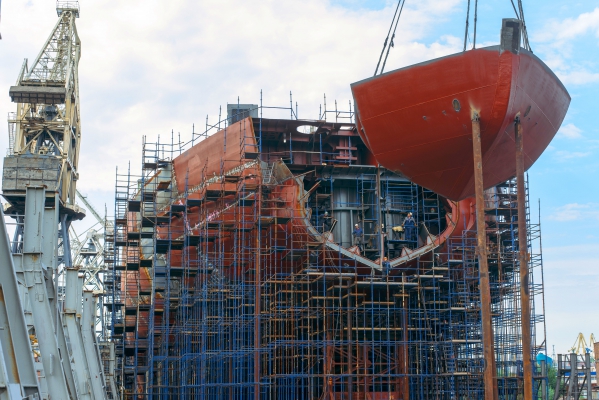
Norway’s environmental prosecutor fines Equinor a record amount following Bellona complaint
Økokrim, Norway’s authority for investigating and prosecuting economic and environmental crime, has imposed a record fine on Equinor following a comp...
News

Publish date: May 12, 2016
News
MURMANSK – As Atomflot, Russia’s nuclear icebreaker port awaits the launch of its newest vessel the Arktika, the company’s head has said the main priority for the new line of ice vessels will be supporting oil projects in the sensitive Arctic.
Billed by official Russian media as “the most powerful icebreaker ever built,” the Arktika exceeds standard dimensions, weighing in at 173 meters long, 34 meters wide, and with a water displacement of 33,540 tons.
But putting the hull of the Arktika on water has been delayed twice. It was first scheduled to hit water in December. That was pushed back to May.
The icebreaker port’s Vyacheslav Ruksha made the remarks at the Atomic Energy in the Arctic: Ecology and Safety conference currently underway in Murmansk.
The new line icebreakers have previously been pushed as a necessity for ensuring safe passage through the Northern Sea Route and building up infrastructure along the way in a bid to make it competitive against the Suez Canal – which experts last month told Bellona was something bordering on fantasy.
 Traffic is waning on the Northern Sea Route. (Photo: провэд.рф)
Traffic is waning on the Northern Sea Route. (Photo: провэд.рф)
On Wednesday Ruksha also dismissed that idea, saying: “It wouldn’t be right to speak about competition between the Northern Sea Route and the Suez Canal.”
Instead, he said icebreakers now “have a other tasks.”
“In the future, the new icebreakers will facilitate access to our hydrocarbon resources in countries of the Asian Pacific area.”
Crude new mission for icebreakers
Though it’s hardly a secret that Russian icebreakers have long been considered a major component of potential hydrocarbon exploration in Arctic waters, Ruksha’s Wednesday announcement was the bluntest revelation by a Russian official that new icebreakers will eschew other projects in favor of assisting in controversial oil development.
“Well it is not very surprising if you have study the actual numbers on transit and cargo passing through the entire Northern Sea Route,” said Nils Bøhmer, Bellona’s executive director.
“But it is surprising coming from Ruksha – is this a signal of new Russian policy?” said Bøhmer.
If so, it may point to a policy that may be doomed to failure. On Monday Royal Dutch Shell, ConocoPhillips and numerous other oil majors abandoned drilling plans in the US Arctic after spending more than $2.5 billion dollars and a decade to ramp up their Arctic drilling programs.
The costs associated with drilling in harsh climates and bringing that crude to market when oil is hovering around $30-$40 per barrel just won’t pay the bills, numerous analysts have said.
 Eni Norway and Statoil's Goliat rig in Arctic waters. (Photo: Statioil)
Eni Norway and Statoil's Goliat rig in Arctic waters. (Photo: Statioil)
Still, Russia and Norway are taking their Arctic gambles. In March, Norway’s Statoil and Italy’s Eni positioned their Goliat rig – the northernmost in the world – in the Barents Sea and put it into service.
Russia, however was the first to drill the Arctic with state corporation Gazprom’s storied Prirazlomnoye platform situated in the Pechora Sea. In 2014, the rig produced 70,000 tons of substandard, low cost crude blend called ARCO, which it sold to France’s oil giant Total.
Ruksha noted that the new oil-centered tasks for Russia’s icebreaker fleet were a long way from its original intention of delivering nickel ores from Norilsk Nickel, the world’s largest producer of nickel and palladium.
With the new line icebreakers hull expected to be lowered down its slip into water in June at St Petersburg’s Baltic Shipyard, Ruksha says the new icebreaker will be half complete.
June date for hull launch tied to purse strings
Mustafa Kashka, Atomflot’s general director, said the construction is expected to proceed in fits and starts depending on financing.
“The fundamental, most expensive equipment was only delivered this year, like the reactor and turbines,” Kashka told Bellona in a side interview at the conference. He also said the lowering of the hull into the water is not fixed on a precise date. Water levels along the Neva River, where the Baltic Shipyard stands, have been consistently lower than hoped.
 The old nuclear icebreaker Arktika, which is undergoing dismantlement.
Credit: Atomflot
The old nuclear icebreaker Arktika, which is undergoing dismantlement.
Credit: Atomflot
But Kashka said that though “the construction schedule is tight, it’s being observed.”
Ruksha indicated the new boat is scheduled for launch in 2018, but complained about how long it had taken.
“The decision to build the lead icebreaker was taken in 2000, with construction expected to be complete in 2018,” he told Bellona. “That is, from decision to completion 18 years passes – its time to make decisions about construction.”
Dismantling old icebreakers
Meanwhile, Ruksha said the nuclear icebreakers Sibir, Arktika and Rossiya were in cold shutdown. The Yamal would face the same fate if its reactor’s operation time is not extended in 2018, said Ruksha.
The Sibir is already headed to the metal bone yard. Ruksha told Bellona the vessel will be hauled from Atomflot to the Nerpa Shipyard in June for full dismantlement, which is expected to be complete by 2017.
Anna Kireeva contributed reporting to this article.

Økokrim, Norway’s authority for investigating and prosecuting economic and environmental crime, has imposed a record fine on Equinor following a comp...

Our op-ed originally appeared in The Moscow Times. For more than three decades, Russia has been burdened with the remains of the Soviet ...

The United Nation’s COP30 global climate negotiations in Belém, Brazil ended this weekend with a watered-down resolution that failed to halt deforest...

For more than a week now — beginning September 23 — the Zaporizhzhia Nuclear Power Plant (ZNPP) has remained disconnected from Ukraine’s national pow...